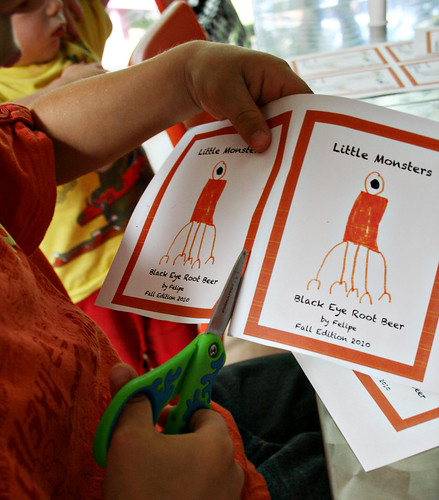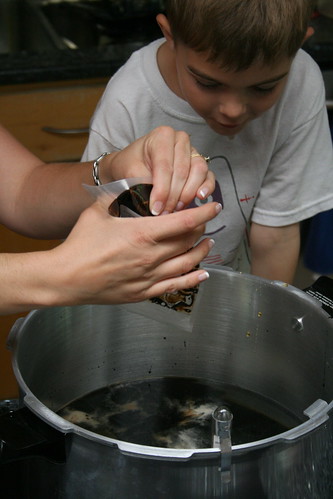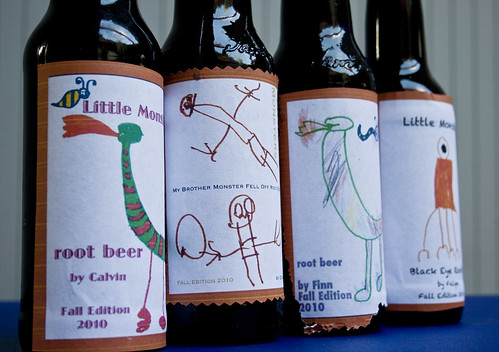I fondly remember the days when I regarded soda as a special treat. My favorites were birch beer, cream, and the crazy fruit flavors of Squeeze soda. I loved visiting the small Squeeze plant nearby and picking among the lollipop-colored sodas. My dad relished Moxie, which I found horribly bitter. But we did find common ground with root beer, which we occasionally brewed ourselves.
My boys love "root berry," a rare treat reserved for the handful of baseball games we attend each summer. And Anna's boys savored a souvenir pack of Route 66 root beer from a vacation on the fabled highway.
So we opened the Little Monsters Root Beer Brewing Co. for an afternoon to learn how soda is made -- kitchen science! The kids were thrilled, and intrigued by the element of danger: a large, bubbling cauldron, and a small chance of exploding bottles.
 Anna turned scanned copies of the kids' drawings into custom labels. The kids cut them out while we prepared the ingredients.
Anna turned scanned copies of the kids' drawings into custom labels. The kids cut them out while we prepared the ingredients.You can buy a modest brewing kit online for $15 to $30. In retrospect, I should have gone this route. I thought I'd do better at a local brewing supply shop. I hadn't done my research, and had no idea it was OK -- in fact, even preferable -- to make root beer in recycled plastic bottles. Instead, I spent more than I should have on things like a $15 gadget to secure metal caps onto our recycled glass bottles.
We used a Gnome soda recipe that called for yeast, honey, cane sugar, water, and root beer extract.
It's easy to make: You need to use a thermometer to monitor the temperature of the mixture, but there's nothing tricky about the process. The kids took turns dumping ingredients into the giant canning pot, marveling at the amount of sugar. We talked about how yeast works, in foods like bread and in root beer.

While mixing up the soda was easy, bottling and storing it was more problematic. Because of that yeast.
Yeast basically eats sugar, creating the carbonation. Chilling the bottles gets the yeast to quiet down. If the carbonation process continues unchecked, pressure builds up and bottles can explode.
So the bottles need to stay warm long enough for the yeast to do its thing, but not so long that the bottles burst. What I read and was told recommended letting the bottles to sit out for 24 to 48 hours. That seems a long window when you risk an explosion.
Exploding bottles are no fun. As Anna could tell you.
Which brings me back to plastic. If you use plastic bottles, there's no risk of shattered glass in your kitchen or refrigerator. And you'll know it's time to chill your soda and quiet down the yeast when the plastic bottle becomes firm.
We chilled ours after 24 hours, and waited a few days to open the first bottle. The kids were giddy ... and then they picked up on the aftertaste. Strong, dark, a little medicinal. It didn't stop them from enjoying their custom soda, but they didn't gulp it down like they do at the ballpark. But they didn't mind at all: The soda was OK, but the grand experiment was "awesome!"
Two months out, and I find the flavor in the few remaining bottles has mellowed some and is more enjoyable from start to finish. We might experiment with another brand of extract, a smaller batch, and plastic bottles in the future.



1 comment:
Fascinating! If it wasn't so darn cold over here today I'd be ordering a kit.
Post a Comment